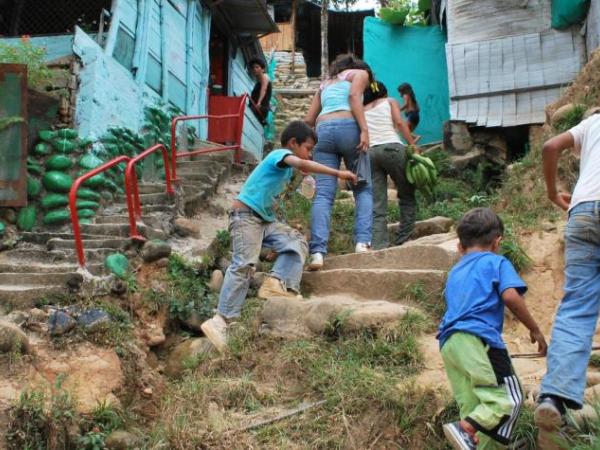2021 showed a significant reduction in poverty figures at the national level, as it went from a rate of 42.5% in 2020 to 39.3% of the population in this condition for last year, as revealed this week by the National Administrative Department of Statistics (Dane). However, for the population living in rural zoneson the contrary, meant a setback.
(Fedesarrollo estimates that rural poverty in the country has been reduced).
The statistical entity reported that, for the period of 2020, the monetary poverty rate – which is measured according to the financial capacity of families – fell in rural areas, despite being the year of the pandemic. According to Dane, in 2020 the incidence of poverty in rural areas fell 4.6 percentage points (pps), to 42.9%, but in 2021, on the contrary, it rose again: 1.7 pps, to 44, 6%.
That means, in rural areas of the country there are currently 4.96 million people living in monetary povertyand last year another 220,522 people fell into this condition compared to 2020.
(Government announced increase in the Solidarity Income subsidy).
The director of Dane, Juan Daniel Oviedo, explained that in the rural area, for the year 2020, “the effects of free home public services, especially for electricity, which were in force in both semesters of 2020, led to the cost maintenance of basic conditions will go from $212,121 to approximately $200,000”.
However, according to Oviedo, with the recovery of normality in 2021, and the absence of these free schemes, there was a return to a trend where there is a evolution in prices that impacts this populationand the poverty line in rural areas was $226,520, which implies that this is the monthly amount – or less – with which the almost 5 million people living in poverty live in the countryside.
In addition, according to the director of the Dane, food inflation also affected the escalation of poverty lines.
FIELD PANORAMA
The situation of families in the countryside is structurally more complex and they are more likely to live in conditions of monetary poverty, and according to Roberto Angulo, founding partner of the Inclusion firm and also a member of the committee of experts on poverty that advises Dane, the recovery in terms of poverty was heterogeneous.
“In rural areas what we see is that poverty increased 1.7 percentage points, we have a drop at the national level and in the cities, but in rural poverty it increased, and although it is still below pre-Covid figures, it worsened in last year,” says Angulo.
The expert clarifies that the effect of free public services, which generated a cheaper line in 2020, is over, since there was no exposure of rural households to these subsidies in 2021, which generates a “rebound effect” on poverty.
Angulo also indicates that there are several elements that play for or against poverty: growth, inequality and inflation, and maintains that in rural areas “growth did not beat inflation”, and great Part of this increase in rural poverty is explained because it had a much greater counterforce than the effect of growth in 2021, which was the increase in prices.
“It is striking that inequality in the countryside played against the reduction of poverty, unlike in the cities, the effect that marked the increase in poverty was not only inflation, but there was a change in inequality. And although the aid had an important effect, it did lose its effect on the field compared to last year”, indicates Angulo.
If the figures presented by the Dane are reviewed, during 2021 the social programs had a positive impact 3.6 percentage points above the national poverty indicator. In the case of the municipal capitals they contributed 2.8 points to the alleviation of monetary poverty, and in the countryside 6.5 percentage points.
However, Angulo points out that the impact of these in rural areas in 2020 was even stronger in rural areas. “There was a loss in the power of aid in rural areas, especially when we look at extreme poverty. While they reduced the indicator by 9.7 percentage points in 2020, in 2021 they only reduced 7.9 points”.
At the national level, the extreme poverty rate, which looks at people who live on less than $161,099 per month, was 12.2%, while in 2020 it was 15.1%. In rural areas the proportion was 18.8%, compared to 18.2% in 2020.
On the other hand, and in the midst of these figures, the Fedesarrollo think tank expressed some objections to Dane’s measurement of rural poverty. The entity’s executive director, Luis Fernando Mejía, assured that in reality “rural poverty was reduced in 2021 compared to 2020, while official figures suggest an increase in rural poverty in the same period.”
Fedesarrollo questions the methodology used by Dane to calculate the poverty line in 2020 in rural areas, and they estimate that the figure was 46.8% in 2020, and therefore it would have been reduced by 2.2 pps, to 44.6 % in 2021.
SOLIDARITY INCOME
In his considerations, the Dane assured that the cash transfer programs were one of the keys to reducing poverty in 2021, and yesterday the President Iván Duque announced an increase in the amount of Solidarity Income, which will go from $190,000 a month to $200,000 starting in May.
“Understanding the effort that has been made and, above all, in order to strengthen the economic situation of the most vulnerable, the payment will rise to $400,000 bimonthly,” confirmed the president.
According to Duque, this measure is taken as a reinforcement for this tool, which has helped compensate for the loss of income of the poorest households as a result of the economic crisis caused by the covid-19 pandemic. The program currently benefits 4 million households.
The Government’s goal is to mark the path to return to pre-pandemic levels in 2022.
LAURA LUCIA BECERRA ELEJALDE
BRIEFCASE








